Trust is the basis of the most successful work trainers and riders do. When it comes to starting young horses, there are countless methods, but the best of them always gain the horse’s trust from the beginning. Then throughout his training, the horse must never be put in a position where he feels threatened or vulnerable. He should never feel that there is no way out.
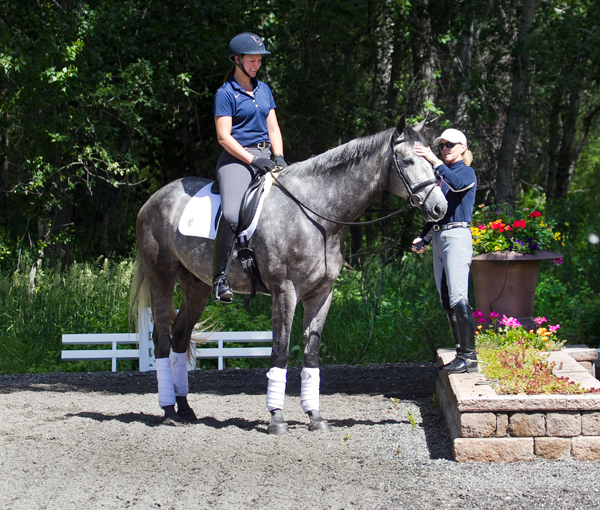
© Mary Cornelius
Because of my small size—I’m only 5 feet—I need to be able to communicate with my horses in this relaxed, trusting way. Some of the horses who come our way at Peggy and Parry Thomas’ River Grove Farm, in Sun Valley, Idaho, where I’ve been training horses for nearly 40 years, have already been started and may never have experienced the kind of communication and trust I need. For example, when we get a horse from an auction, for the first 30 days, I return to how we start horses here.
Slowly, we build our communication skills on the ground and under-saddle until the horse yields quietly to light pressure and understands turning, walking, stopping and backing. The whole point is to get away from being rough by taking this initial time for building trust. It doesn’t take aggression to get this done. Most riders buy horses who are already started, but keep this basis of trust in mind before going on to the next step in your training.
Ride in Balance
When horse and rider are balanced, they can be relaxed. And while you’re tending to the balance in your horse’s body, he’ll become more relaxed in his mind.
During my travels around the United States as developing coach, I’ve found one major misconception about training among riders at all levels: They often sacrifice the balance by riding too forward.
When the rider thinks her horse needs to go more forward, she sometimes ends up running him off his feet, which creates tension and a loss of balance. As a result, her horse loses natural suspension and his good gaits become average very quickly. Also, horses working in poor balance often develop soundness issues. On the other hand, if you let your horse progress and evolve with a relaxed body, you can take an average horse and make him above average.
Here’s an example of what I see often: A judge remarks on a test, “Not covering enough ground.” Many riders misinterpret this comment and will push strongly with the leg and the seat, which actually creates less ground cover along with tension. Holding with your hand, leg and seat too much will stifle your horse’s movement.
Instead of driving, try to lighten your seat a little and see if your horse will just go. If you want to canter with more ground-covering strides, take him out to a field and get in a two-point position. I guarantee your horse will cover more ground because you will have allowed him to move freely under you. You’ll see the result on the following day when you have a happier, more balanced, free-moving horse. Variety also will improve your horse. If you don’t have access to trails, find a way to make training fun for your horse so you don’t drill him six days a week.
Develop Balance
When working on your horse’s balance, keep in mind that horses can’t be balanced under unbalanced riders. We always need to begin with the education and balance of the rider.
Rider Education
In comparing U.S. riders to Europeans, I think we’re behind them in education for two reasons. First, many people aren’t even seeking education. They must feel they don’t need it, which is a dangerous path. For real horsemen, there’s never a time when they can’t learn more. Every day I learn something new, which is what makes my job exciting. How awful it would be to think I knew it all. Also, education is lacking because of the size of our country. We now have many good trainers, but there aren’t enough to help in every area of the country.
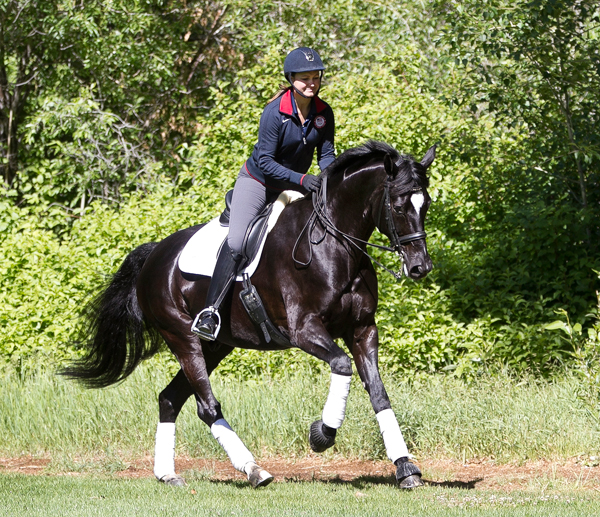
Rider Balance
When it comes to balance, you can’t hope to be in the middle of your horse if the saddle isn’t in the middle. Too often, I see saddles that either put the rider in the back seat or to one side. Then how can the horse find his center? When your saddle sits correctly, you can then find your balance with longe lessons. When you sit in balance, your aids can be used with skill and independence to balance your horse.
Horse Comfort
A poorly fitted saddle, in addition to making you unbalanced, can make your horse sore, which is the cause of many a bad attitude. A horse in pain will never be in balance because he’ll always be trying to shift himself to find a comfortable place. Fortunately, we’re getting better at educating people about saddle fitting. Our horses do a lot for us, and it’s our job to listen to them and be sure we never ask them to do more than they can do. Palpating them is critical to success. Use your hands on your horse’s body to look for places that might be sore or developing unevenly. Only when your horse is comfortable and you’re in balance can you teach him to find a rhythm and a better balance. You’ll do that with transitions and shoulder-fore.
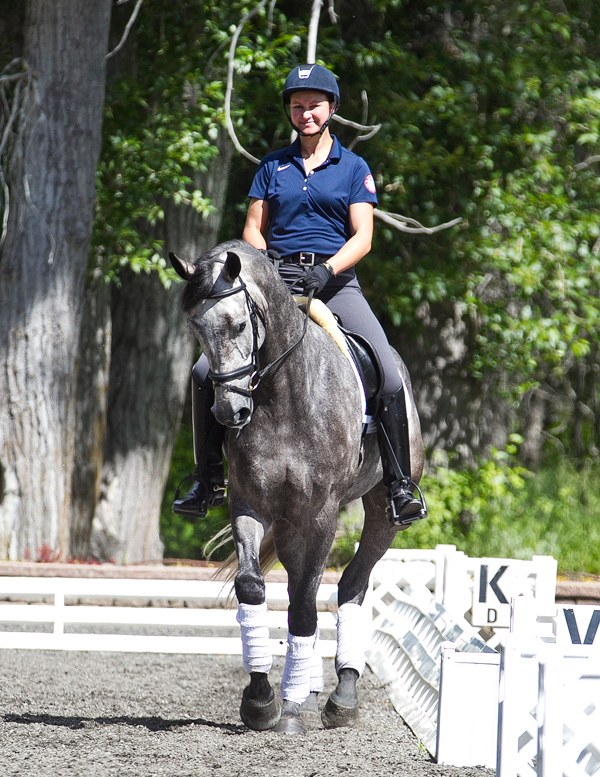
© Mary Cornelius
Transitions and Shoulder-fore
The basis for your horse’s transitions began on the ground when he learned to go, stop and turn from a verbal cue and very light pressure. Then before you even get on, he understands the “brake” and the “gas,” and he has a “turn signal” on either side. He knows how to turn left and right.
Under-saddle, many riders are then inclined to let their young horses run to tire them, but if you’re in the dressage world, you don’t want to take out the brilliance, even when your horse is a baby. You might need to let him trot around a little, but you don’t want to wear him down. You want him to manage the atmosphere because he trusts you enough to relax. Ideally, you want your horse to feel energetic but relaxed and balanced.
To achieve this, work on transitions between the gaits as soon as you can in your warm-up: Walk–halt–walk. Walk–trot–walk–trot. Trot–canter–trot–canter. Try to ride the transitions in shoulder-fore. In shoulder-fore, your horse’s inside hind should track between his two front feet and his outside hind stays in the track of his outside fore. This teaches your horse to position himself so his inside hind leg can learn to carry in balance. As he gets more educated, his balance changes and develops—bit by bit, his weight will shift from his forehand to his hindquarters—and by First Level he can do the more difficult transition: trot–halt–trot.
By Second Level, your horse can do walk–canter–walk—also in shoulder-fore. As he gets sophisticated, those transitions start to shift his weight back and lighten his forehand even more. When he’s educated through the levels in the right way, you get seamless transitions that happen because of your body language—which we’ll talk about later.
Transitions within each gait are helpful, too: Working–lengthening–working, collected–medium–collected, medium–extended–medium. In the beginning, you want to ask for just a bit of collection and then let your horse go forward again. Be cognizant of his strength level and collect only as much as he is able. Overdoing it would be comparable to you doing squats for a long time. This is where rider education comes into play. You need to know if your horse is strong enough and know when he can be pushed to get a little stronger. Ideally, your trainer watching from the ground can help you strive for the right kind of goals.
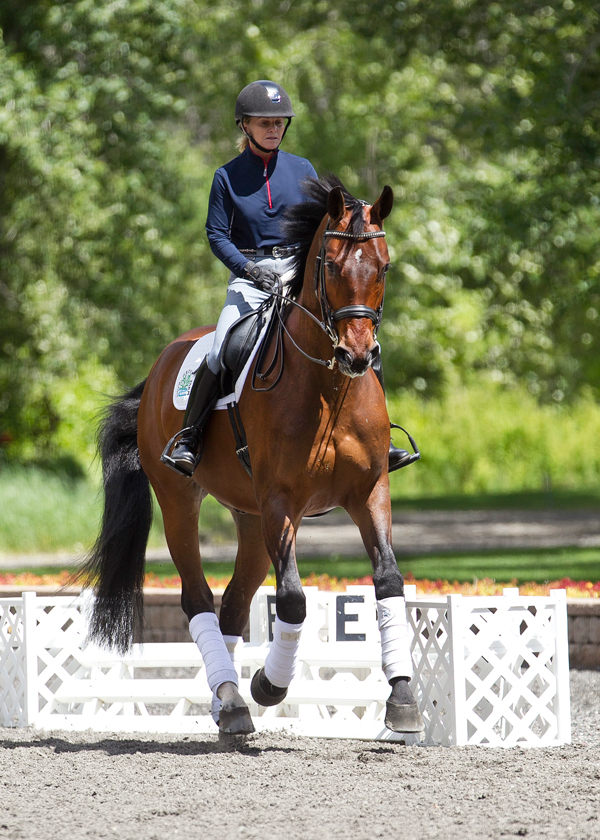
© Mary Cornelius
Goals Can Be Your Enemy
We need to have goals, but the goal can also be your enemy if you don’t listen to what your horse is saying. Here’s an example: Your goal is to do Third Level in the spring. You have great simple changes, but the flying changes are tense and out of balance. At this point, you can go down a very dangerous path. While the focus is on getting the changes, riders often don’t notice when they start to lose the quality of the canter. They’re focused on wanting the horse to be more together, more engaged, more this and more that instead of focusing on the quality of the canter.
This isn’t an uncommon situation, but when the horse can do a simple change (walk—canter—walk), he can almost always do a flying change. You, however, have to be picky. Repetition of those simple changes doesn’t always improve the horse; good repetition improves him. In the upward transition from walk to canter, did your horse slip into a few trot steps or did he accelerate? If so, you need to walk and pick up the canter again with a prompt, clean transition that goes from a four-beat walk to a three-beat canter. You have to control the rhythm and the relaxation. When your horse can demonstrate an excellent canter depart from walk, think about what your aids were, and ask yourself:
- How big were my aids? If the transition was good, they were probably quite small.
- Did I put my outside leg way back? Probably not.
- Did I throw my weight to the inside? Probably not.
- Did I throw my reins away? Probably not.
Now when you go to do a change, do it with the same beautiful balance that you had in the walk–canter transition. Don’t let your aids put your horse out of balance. Often when a rider has trouble with changes, her understanding of the change is what’s missing because she thinks she needs to physically help, so she throws around her body. Those important details of the aids get lost in the goal.
People also forget that horses learn in different time frames and not every horse will do Grand Prix at 9 years old. That’s OK. There shouldn’t be a rush to move any horse up a level. In addition, not every horse ends up being what you want him to be. The time comes, in some cases, when you have to say, “Do I continue down this path where neither one of us is happy or do I find this horse a new home?” That’s a difficult place to be, but most riders experience it at some point in time. Pushing to the goal gets in the way of our primary job as trainers—to preserve our horses’ health and mentality.
Gymnastics for Better Balance
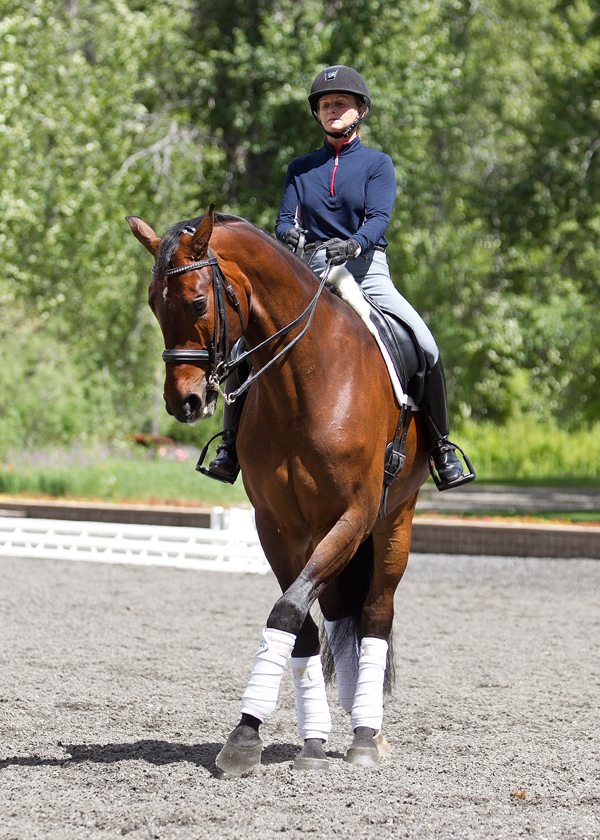
© Mary Cornelius
Gymnastic work that honors the integrity of your horse’s body will always improve him. Walk in shoulder-fore or renvers, do a turn on the haunches, then a turn on the forehand. Trot or canter and move your horse around to get his mind concentrating on you. It’s fun for him.
Use positive repetition as opposed to drill. Positive repetition is meaningful because you repeat something until your horse gives you a good response, and then you reward him and stop doing it. You move on to something else. For example, a Grand Prix horse doesn’t need to school the steep half-pass as it is in the test. You can do that steep half-pass for only a few meters and if you’re pleased with it, you can pat him and move on to something else. Likewise, if your horse accomplishes everything you wanted in 25 minutes, take him out of the ring and go on a hack. You can use the extra time for fitness rather than drilling. This will keep your horse’s mind and body in a good place.
Body Language For Light Aids
Every horse is different, of course, and some horses, especially at the upper levels, can be a bit stronger in the hands, but that is because their engines are working hard, which is a good thing. You always want to ride your horse from back to front.
By this I mean that in the working trot and canter, you want to feel as if you could easily access medium or extended work—that your horse could take you in those gaits. But that doesn’t mean he should be impossible to carry in your hands or that he’s running forward. Again, it’s having the education to know and feel that your horse is moving forward in front of your leg in a balanced way. You can accomplish this with clear aids and a little use of a dressage whip. Be careful, however, not to let the whip become a crutch. I see many riders who use the whip instead of their legs, sometimes becoming unaware they are doing this. If you need the whip, use it and be done with it. Avoid nagging with it. Ride with clear aids to keep your horse sharp.
When your horse is listening to your clear aids and moving from his engine in balance, you can start to wean him off your hands and he will listen more and more to your body language. Your normal rein aids can get quieter and quieter as your horse starts to understand your seat and weight aids.
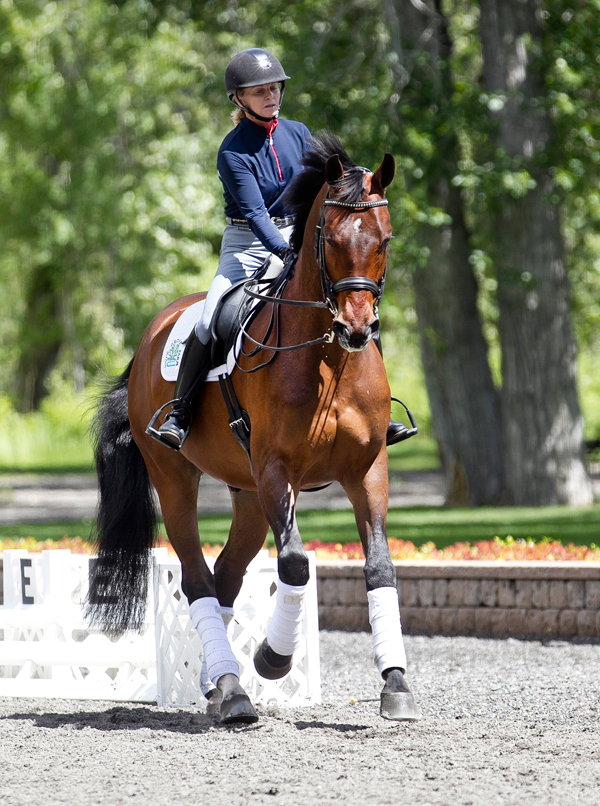
© Mary Cornelius
When I see that a rider has done a beautifully balanced canter pirouette without needing much help from the hands, I ask her to get up in a half-seat, pat the horse and let him stretch long and low. He will, of course, think he’s done, but then I say: “Pick up your reins just lightly and bring him back to that same collected canter with just your body language—not with your hands.” The minute you feel him start to collect without your hand, praise him. Then, with just your body, say, “Come a little more on the spot.” You can wean your horse off the hand this way and ride with very small aids. It’s fun to see riders learn that they can do it easily. If you are ever able to watch Olympian Steffen Peters in the warm-up arena, you’ll see that he does this all the time, but anyone can do it in whatever exercise you’re working on if you just let yourself believe that where you put your body can tell your horse to come back. You’ll need very little hand. If you’re able to do that perfect pirouette or the movements you currently are working on and you need only your hands for little reminding aids, then you can return to collection with only your body language.
As you work, you can check to be sure your horse is in balance from aids other than your hands: Occasionally, pat him on the inside neck, and ideally, he won’t lose the bend, the rhythm or the balance.
When you and your horse are in balance, the connection will always be good and you can ride any movement with light aids. I’m not saying that you won’t need to make your horse sharp and in front of your leg, and I’m not saying you won’t need a strong half-halt every now and then. But if you’re riding with a strong seat and leg all the time, then your light aids won’t work. When your horse is ridden correctly in balance, it doesn’t take a lot of strength. Let this balance become a part of your everyday riding. Educate yourself, listen to your horse and ride thoughtfully.
With Peggy and Parry Thomas’ Brentina, Debbie McDonald helped lead the U.S. Dressage Team to bronze medals at the 2004 Athens Olympics and the 2006 World Equestrian Games. They also competed in the 2008 Olympics and the 2002 WEG. In 2003, the pair became the first American combination to win the World Cup Dressage Final. They also earned team and individual gold medals at the 1999 Pan-American Games. Debbie served as US Equestrian’s Dressage Development Coach before taking on the Technical Advisor role.










